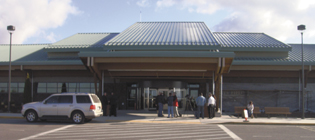
Since 1997 the Redmond Airport (RDM) has grown by nearly 50 percent to 238,195 registered passenger flights in 2012. Since that time the airport has grown with several changes in facilities expansion, carriers and most recently acquiring Robert Nobel as an interim airport manager.
In regards to the appointment of a new airport manager, Redmond City Manager Keith Witcosky says, “The decision to bring in Bob Nobel was not a statement about the direction the airport was going. We have an incredible facility with numerous national flights which reaped the benefit and talents of Bob’s successor airport directors.”
Former Airport Manager Kim Dickie, hired in 2011 to replace long time Airport Manager Carrie Novick who retired, is now serving as the airport deputy director.
Given the importance of the airport to the region’s growing economy and transportation needs, Nobel was lured to Redmond by Witcosky to work on long term airport goals including assessing the current environment, identifying critical issues and developing the processes for implementing initiatives.
Nobel has more than 18 years of experience in numerous public aviation leadership roles across Oregon. He served as the airport manager for the City of Eugene from 2001-07. Witcosky says Nobel’s knowledge, skills and experience will position Redmond Airport for long term success as it continues to play an essential role as an economic driver for all of Central Oregon.
With a steady increase over the years in passenger flights and the upgrades and expansion of facilities, the Redmond Airport has positioned itself to be the central hub for transportation in Central Oregon. Nobel explains, “In our region there are no freeways, rail or other carriers so the airport becomes the main transportation link.”
This resonates with Witcosky who has a goal for Redmond’s prized asset when he says, “Looking ahead, we want the Redmond Airport to become known as the best airport of its size in the nation. That means it will be the preferred choice for commercial air carriers and general aviation clients based on the best services, infrastructure and facilities of any airport of similar size in the country. Clients will recognize this value by investing through leases and other contracts which allow the airport to be a self-sustaining and continually improving community asset.”
The growth in flights and facilities can benefit all travelers to and from Central Oregon, but when one carrier discontinues service it can leave the perception that things aren’t right at the core of the regional airport transportation system. Such was the case when Allegiant, the Las Vegas-based vacation and leisure travel airline, ended flights from Redmond in August 2012.
But in a positive development in early June of this year, the Redmond Airport welcomed American Airlines and their new daily scheduled flights to Los Angeles. On November 4 this year, Alaska Airlines added a daily early morning commute to Portland.
However, regardless of these additional carriers and the potential increase in flights it will provide, Interim Manager Nobel is hard at work developing a mid and long range plan for the future growth and development. Nobel says, “At this point, I am in the process of assessing the environment, identifying the critical issues and understanding the processes used for implementing initiatives.”
Nobel suggests that there are three primary goals over the next six months:
1. Assess the airport organizational structure and resources and determine what changes, if any, are need to position the airport for future success.
2. Assist with the recruitment of a qualified candidate to assume the role of airport director for the long-term.
3. With customer service and financial self-sufficiency in mind, focus on several significant business transactions and policy decisions that need prompt resolution.
Other goals would also include:
• Formalize community support for an on-going air service development and marketing program.
• Review the Airport Master Plan and the Airport’s capital improvement plans, and determine if they need to be updated. Garner support for the Airport’s ConnectOregon V application.
• Prepare the airport budget for 2014-2015
• Enhance general aviation, general aviation services and compatible aeronautical activities.
• Promote and facilitate economic development and land development.
In evaluating the present condition of the airport Nobel says, “First, the status of RDM Airport is already extraordinary in many ways. There are some things that need improvement, but there is no need for triage. The Airport already has a beautiful facility, good commercial air service, dedicated employees and business associates, a supportive governing body and region-wide utilization.”
The City of Redmond owns the airport so it needs to be in cooperation with its future development and growth. Witcosky adds, “Roberts Field is one of the primary drivers for economic development across Central Oregon. It is the only true commercial airport in the region and as such it must do its part to increase commerce, economic activity and job growth.”
Redmond’s new city manager shares his goals of what the airport can be for the region, “Our vision is that aviation, aerospace and other traded sector industries continue to invest and cluster around the airport. Partners such as Redmond Economic Development Inc. (REDI) and Economic Development for Central Oregon are working with us to create jobs and attract private sector investment at the airport.”
To that end the airport wants to position itself to attract the type of development that Witcosky envisions within the airport master plan by rezoning some of its surrounding land. Jon Stark Manager of REDI says, “Within the 1,500 acres of Industrial land in Redmond is a soon-to-be newly zoned 465 acres of industrial land, some private and some airport owned, that will include parcels from 30-50 acres for attracting larger scale industrial and manufacturing companies.”
Along with future economic plans for commercial and industrial partners Witcosky laid out some short and midterm goals, “Over the coming months there are a number of initiatives in progress, which includes successfully completing lease negotiations with providers of airport services, the United State Forest Service lease, establishing written minimum standards, general aviation leasing policies and other rules and regulations, as well as work associated with establishing predictable, reliable business practices and positioning the team.
“RDM currently has good air service and the region is well served by those airlines operating here. In the near future, I plan to meet and collaborate with community leaders who have already been involved with air service development and create a list of priorities/objectives. Hopefully, we will establish an-going program that can address air service comprehensively and not just by project.”
Protecting the customer relationships with air carriers is another important goal for the airport said Nobel, “It will also be important to make sure that our incumbent air carriers are successful and profitable so that our partnerships can be sustained for the long term. There needs to be a focus on the success of the new American Airlines service to LAX and the encouragement of its utilization. Increasing seating capacity to the east and upgrading aircraft are also goals that are foreseeable.”
As the goal setting tasks are underway, Witcosky asks, How do we get there? But he is quick and ready to answer, “We provide top notch customer service, build relationships with our clients and deliver predictable outcome oriented results…we need to remain ambitious and continuously earn respect.
“I want to help position RDM for long term success and for it to be the best airport of its size in the country. This vision is aspirational and is also achievable.”





